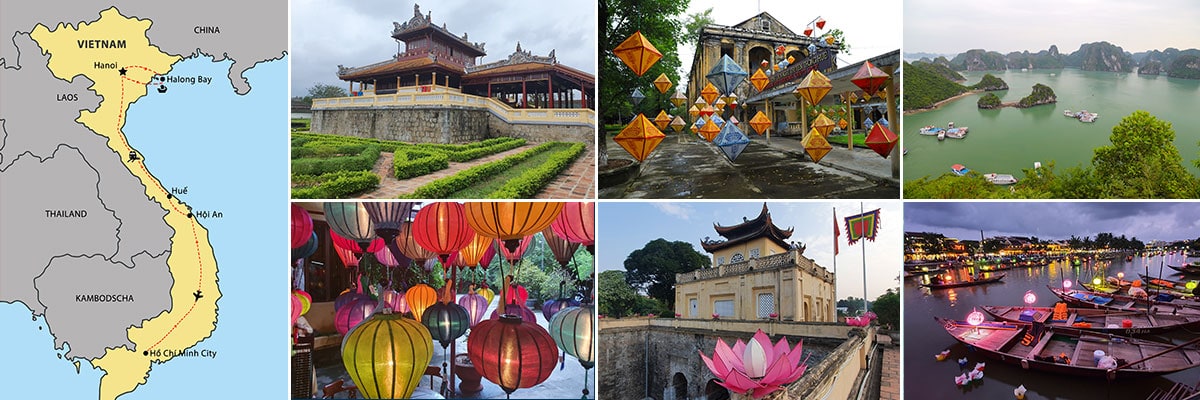We spent the last day of our tour “Typical Vietnam” with Gebeco with a trip to the tunnels of Cu Chi, which served the Vietcong during the Vietnam War as a retreat and operational base.

Table of contents
Things to know about the Cu Chi’s tunnels
The Cu Chi Tunnels are located about 60 kilometers northwest of Saigon and are a tunnel systemin which Vietnamese partisans hid during the Vietnam War from 1960 to 1975. The first tunnels had already been dug in 1948 in the fight against the French to protect weapons, supplies and people. When the US later sent troops to Vietnam, they set up a headquarters not far from Cu Chi – and at that time had no idea that the enemy was lurking among them all the time.
War relics of the Vietnam War
At the entrance of the facility there are some wartime relics ona meadow, such as tanks, guns and combat helicopters.
The construction of the tunnels
In the 1960s, the tunnel system was massively expanded until it ended up with a total length of about 200 kilometers and spread over three levels. The top level was about 3 to 4 meters underground. The second floor was 6 meters underground and served as a shelter for children, the elderly and injured soldiers. The lowest level was 8 to 10 meters underground and housed hospitals and other health resorts. The underground buildings were connected by tunnels of approx. 80 cm height and 60 cm wide. Originally, the tunnels were dug so narrowly that no non-Vietnamese could pass through. During the Vietnam War, however, U.S. Army soldiers actually managed to capture some entrances and sections. However, they failed relatively quickly due to the dimensions of this huge tunnel system and the tricks and deceptions of the enemy Vietcong.
A demonstration for the entry hole to the tunnels
One of the local guides who accompanied us on the tour of the site demonstrated to us very well how the Vietcong could slip unnoticed into the tunnels. The entrances to the tunnels were ground holes camouflaged with grass cover and foliage. In some cases, the entrances were also secured by simple but effective traps such as bamboo skewers.
A walk through a tunnel
Most of Cu Chi’s tunnels have since fallen into disrepair or been buried. Only a few courses have been preserved, through which you can walk yourself. In the meantime, this was artificially widened for tourists, i.e. extended to a height of 1.20 metres and a width of 0.80 metres. However, there was also a tunnel, which still had the original size of about 0.8 meters height and 0.6 meters width – and of course we are “swept through” here in the duck aisle, because we just wanted to know how this must have felt earlier. And we only have the slighthint of a clue. The tightness, the oppressive air and the darkness… with little food and a life in a state of war. It must have pushed the Vietcongs to their limits.
More impressions of the Cu Chi tunnels
The tour of the grounds of the Cu Chi Tunnel impressed us very much. It is also interesting that the American forces, despite several attempts to destroy the tunnels, failed to destroy them – neither by flooding, by heavy bombardment, or by the introduction of poison gas.
After a 1.5 hour tour of the facility we made our way back to Saigon, where we arrived again in the afternoon. We had a few hours of free time in Saigon before our plane went back to Germany in the evening.
All travelogues from Vietnam
During our 10-day trip with Gebeco through Vietnam we got to know many different sides of the country. Starting with the pulsating capital Hanoi and the millions of scooters on the streets, the majestic beauty of Halong Bay, an exciting night train ride to the cultural centre of Hue, further to the old town of Hoi An, which is a UNESCO World Heritage Site, and on to the megacity of Saigon in the south of the country. Our trip was very varied and full of contrasts and here you can find an overview of all travel reports: » Day 1: Our trip “Typical Vietnam!” with Gebeco (Vietnam)
» Day 1: Our trip “Typical Vietnam!” with Gebeco (Vietnam)» Day 2: Hanoi – Tourist Attractions, Things to Do & Photo spots (Vietnam)
» Day 3: Halong Bay – A day trip from Hanoi (Vietnam)
» Day 3: The Night Train from Hanoi to Hue (Vietnam)
» Day 4: Hue – Citadel & Imperial Palace with the Forbidden City (Vietnam)
» Day 4: Hue – Emperor’s Tomb of Minh Mang & Thien Mu Pagoda (Vietnam)
» Day 5: From Hue to Hoi An – The Cloud Pass & Da Nang (Vietnam)
» Day 5: Hoi An – Tourist Attractions, Things to Do & Photo spots (Vietnam)
» Day 6: My Son – The ruins of the ancient temple city at Hoi An (Vietnam)
» Day 7: Saigon – Die Sehenswürdigkeiten von Ho Chi Minh Stadt
» Day 7: Saigon – A culinary Vespa tour of the city (Vietnam)
» Day 8: The Mekong Delta – A bike & boat tour (Vietnam)
» Day 9: Cu Chi – The Tunnels of the Vietcong in the Vietnam War (Vietnam)
